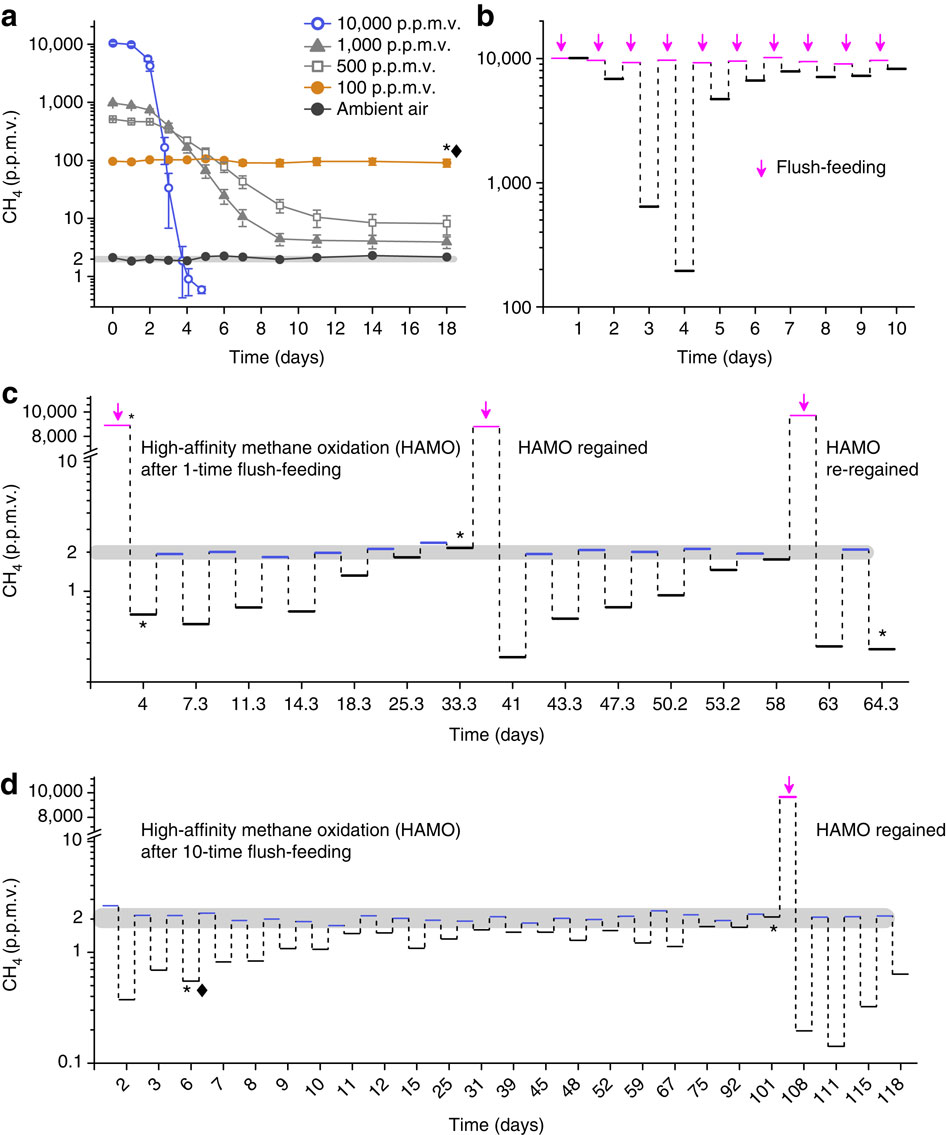当前位置:
X-MOL 学术
›
Nat. Commun.
›
论文详情
Our official English website, www.x-mol.net, welcomes your
feedback! (Note: you will need to create a separate account there.)
Conventional methanotrophs are responsible for atmospheric methane oxidation in paddy soils.
Nature Communications ( IF 14.7 ) Pub Date : 2016-06-01 , DOI: 10.1038/ncomms11728 Yuanfeng Cai , Yan Zheng , Paul L. E. Bodelier , Ralf Conrad , Zhongjun Jia
Nature Communications ( IF 14.7 ) Pub Date : 2016-06-01 , DOI: 10.1038/ncomms11728 Yuanfeng Cai , Yan Zheng , Paul L. E. Bodelier , Ralf Conrad , Zhongjun Jia

|
Soils serve as the biological sink of the potent greenhouse gas methane with exceptionally low concentrations of ∼1.84 p.p.m.v. in the atmosphere. The as-yet-uncultivated methane-consuming bacteria have long been proposed to be responsible for this 'high-affinity' methane oxidation (HAMO). Here we show an emerging HAMO activity arising from conventional methanotrophs in paddy soil. HAMO activity was quickly induced during the low-affinity oxidation of high-concentration methane. Activity was lost gradually over 2 weeks, but could be repeatedly regained by flush-feeding the soil with elevated methane. The induction of HAMO activity occurred only after the rapid growth of methanotrophic populations, and a metatranscriptome-wide association study suggests that the concurrent high- and low-affinity methane oxidation was catalysed by known methanotrophs rather than by the proposed novel atmospheric methane oxidizers. These results provide evidence of atmospheric methane uptake in periodically drained ecosystems that are typically considered to be a source of atmospheric methane.
中文翻译:

常规的甲烷营养生物负责稻田土壤中的甲烷氧化。
土壤是强大的温室气体甲烷的生物汇,在大气中的浓度极低,仅为约1.84 ppmv。长期以来,尚未有人提出培养这种消耗甲烷的细菌来引起这种“高亲和力”甲烷氧化(HAMO)。在这里,我们显示了由稻田土壤中的常规甲烷营养菌引起的新兴HAMO活性。在高浓度甲烷的低亲和力氧化过程中,迅速诱导了HAMO活性。活性在2周内逐渐丧失,但可以通过向甲烷中冲入较高甲烷来反复恢复。只有在甲烷营养种群快速增长之后,才诱导产生HAMO活性,一项全转录组关联研究表明,同时发生的高亲和力和低亲和力的甲烷氧化是由已知的甲烷营养菌而不是拟议的新型大气甲烷氧化剂催化的。这些结果提供了周期性排放的生态系统中大气甲烷吸收的证据,这些生态系统通常被认为是大气甲烷的来源。
更新日期:2016-06-04
中文翻译:

常规的甲烷营养生物负责稻田土壤中的甲烷氧化。
土壤是强大的温室气体甲烷的生物汇,在大气中的浓度极低,仅为约1.84 ppmv。长期以来,尚未有人提出培养这种消耗甲烷的细菌来引起这种“高亲和力”甲烷氧化(HAMO)。在这里,我们显示了由稻田土壤中的常规甲烷营养菌引起的新兴HAMO活性。在高浓度甲烷的低亲和力氧化过程中,迅速诱导了HAMO活性。活性在2周内逐渐丧失,但可以通过向甲烷中冲入较高甲烷来反复恢复。只有在甲烷营养种群快速增长之后,才诱导产生HAMO活性,一项全转录组关联研究表明,同时发生的高亲和力和低亲和力的甲烷氧化是由已知的甲烷营养菌而不是拟议的新型大气甲烷氧化剂催化的。这些结果提供了周期性排放的生态系统中大气甲烷吸收的证据,这些生态系统通常被认为是大气甲烷的来源。





















































 京公网安备 11010802027423号
京公网安备 11010802027423号